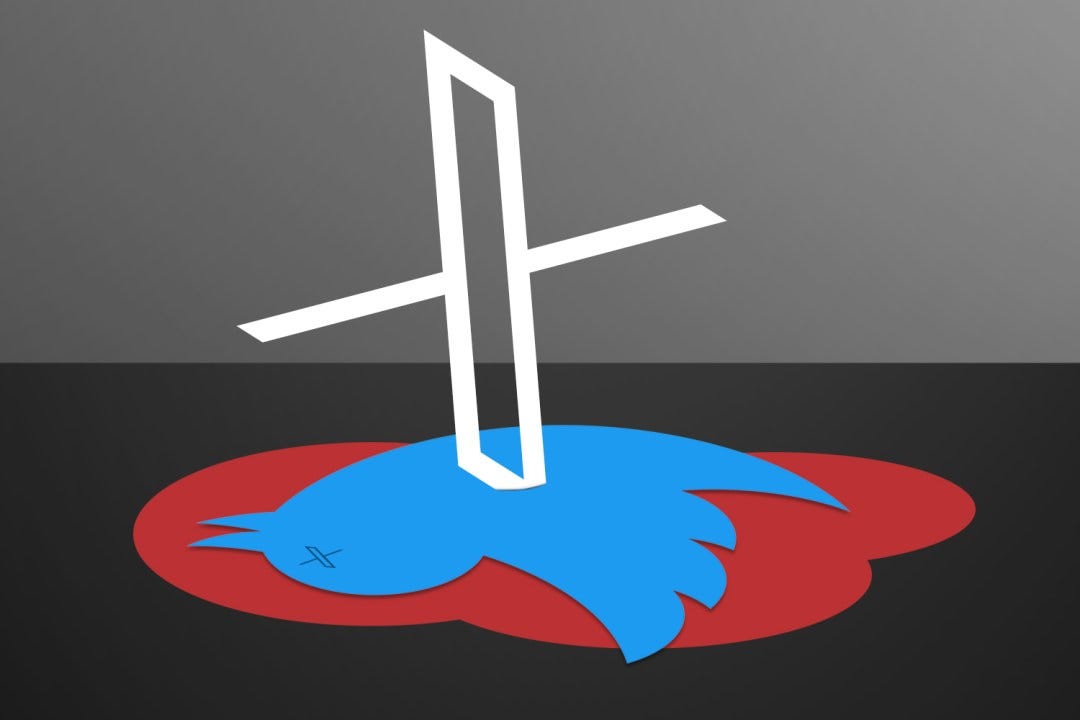X Marks the Grave of Democracy
How Conspiracy Culture, National Conservatism, and Musk’s Digital Megaphone Handed Trump the 2024 Election
As the dust settles on Trump’s improbable 2024 election victory, many of us are left not simply with questions about how this happened but, more urgently, why it did. We’re grappling with a series of disturbing realities—most unsettling is the fact that an adjudicated rapist who inspired an attack on the Capitol just four years ago has once again found his way into the White House. Yet, with clearer eyes and a wider lens, Trump’s path to victory wasn’t a magic trick but a meticulously orchestrated dance of conspiracy, ideology, billionaire-backed networks, and the missteps of his opponents. Together, these forces created a political landscape where the improbable became inevitable. This was a victory of cold calculation, not just charisma.
Trump’s win in 2024 marks a chilling milestone, a victory cobbled together from the same toxic ingredients that have been corroding public discourse and democracy itself. At its heart is a perversion of truth—a grotesque mutation of reality that began as a conspiracy culture, was nurtured by the billionaire barons of industry, and found its voice in Elon Musk’s X. It’s a dark irony that this alliance of populist zealotry and concentrated wealth, wielded in the name of “freedom,” has undone democracy.
Conspiracy Culture: The Poisonous Allure of Simple Stories
The birth of conspiracy culture in mainstream politics wasn’t Trump’s doing alone. Conspiracy culture in America has always held a certain allure—think of the JFK assassination or the moon landing skeptics. But it has now blossomed into a sinister spectacle where “alternative facts” and reality-bending narratives are no longer relegated to the margins; they’re algorithmically catapulted into the mainstream. And Musk’s X, re-branded with a mission of unfiltered “free speech,” is the digital amphitheater where these stories echo.
Conspiracy culture, in its modern incarnation, is bound together by a sprawling and sinister mythology: the spectre of “Cultural Marxism.” This grand umbrella conspiracy theory has become a rallying cry on the far-right, uniting everything from fears of socialism’s return to xenophobic anxieties around immigration, and even the belief that “wokeness” and political correctness are tools to dismantle Western civilisation. Unlike traditional conspiracy theories, which typically revolve around isolated figures or events, “Cultural Marxism” presents a comprehensive narrative, positioning progressivism itself as an existential threat to the Western tradition.
This theory has evolved over time, but its modern shape owes much to Paul Weyrich of the Heritage Foundation and William S. Lind of the Free Congress Foundation, two architects who transformed paranoia into political doctrine. Through their influence, Cultural Marxism has grown into a narrative where a cabal of academics, human rights organisations, the media, the judiciary, and even school systems allegedly work in lockstep to corrode Western values and disempower “ordinary” people. Under this worldview, seemingly innocuous movements—civil rights, feminism, LGBTQ+ rights, multiculturalism—are cast as Trojan horses, harbouring intentions to destabilise society and undermine so-called “traditional” values. Soros-like figures become the villains, “puppet masters” orchestrating immigration, funding “woke” agendas, and deploying political correctness as tools to dismantle the cherished Western way of life.
“Cultural Marxism” purports that Western societies are under siege, that everything from academia to Hollywood is secretly engaged in a plot to emasculate men, erase national identities, and condition future generations to embrace a secular, socialist world order. The theory relies on fear: fear that the freedoms and identities of the West are being erased by elites with their own cryptic agendas. Civil rights movements are, in this view, recast as cynical strategies, waged not to extend equality but to create divisions that tear apart social fabric, all in the name of advancing socialism and destroying “Western tradition.” This belief, often cloaked in intellectual terms, has been injected into public discourse to reframe every movement towards equity as a calculated assault on Western society.
The concept of Cultural Marxism weaves together many threads of old conspiracy thinking, from anti-Semitic tropes about “media control” to Cold War fantasies of “reds under the bed.” But by modernising it, Weyrich, Lind, and their allies ensured it would have broad appeal in a digital age. Its genius lies in its flexibility: it can adapt to new anxieties, co-opting contemporary fears and evolving to include phrases like “wokeness” and “political correctness” as if they were simply the latest weapons in a long-fought cultural war.
For Trump’s campaign, this narrative was a gift. It provided an instantly recognisable villain, a way to frame his opponents as part of an elite conspiracy undermining “real” Americans. Through conspiracy culture and the idea of Cultural Marxism, Trump’s re-election campaign didn’t just run on policies; it offered a mythology. A grand narrative in which sinister forces, cloaked as human rights advocates and educators, use pro-social causes to manipulate the public, erode traditional values, and ultimately weaken the nation. In this worldview, Trump is no longer just a political candidate—he is a crusader, the last bastion of defence against a hidden enemy that seeks to destroy Western civilisation from within.
By placing this theory at the heart of his campaign, Trump tapped into a deep well of paranoia, a desire for simplicity in a complex world, and a resentment towards elites that was shaped, fed, and magnified by think tanks, influencers, and platforms like Musk’s X. The conspiracy culture around Cultural Marxism provided Trump with an ideology that galvanised millions, transforming public discourse into a binary of good versus evil, and leaving little room for critical thought. In a political landscape where the complexities of policy were traded for the simplicity of myth, Trump’s victory became not just possible, but inevitable.
Musk’s dismantling of moderation on X—casting fact-checking aside in the name of “liberty”—created a playground for those eager to distort reality. Through a tangled web of election denial, “deep state” fantasies, transphobia and feverish theories about stolen freedom, X became the perfect storm. It provided a platform where voices of paranoia resonated louder than voices of reason, transforming politics into a game of fear and rage. For Trump, this was a gift wrapped in black velvet: conspiracy culture gave his re-election bid not only a shield from criticism but a fervent base willing to believe, unconditionally, that he was the last line of defense.
The Deconstruction of the Democrats: The Straw Man of “Wokeism” and the Right’s Cultural Strategy
Jon Stewart recently noted the irony in how Democrats, including figures like Kamala Harris, were often cast as the champions of “woke” ideology when, in reality, their policies frequently sought to appeal to traditional Republicans. They reassured voters of their conservative positions on immigration, gun rights, and even fracking, attempting to bridge the partisan divide rather than stoke it. Yet, despite these efforts, the Democratic Party was relentlessly deconstructed and rebranded by the right-wing propaganda machine as a monolithic bloc of “wokeness”—an alliance of enablers of gender ideology, critical race theory, open borders, and creeping socialism. The Democrats’ supposed “wokeness” became a caricature, a straw man that had little to do with their actual positions but everything to do with the right-wing’s effective cultural strategy.
Right-wing activists like Christopher F. Rufo played a crucial role in this deconstruction. Rufo, a senior fellow at the Manhattan Institute, has been one of the architects of a broad campaign to toxify concepts associated with social justice and civil rights under the guise of “critical race theory” and “wokeness.” In a thread on X, Rufo openly described the strategy behind this branding exercise:
“We have successfully frozen their brand—‘critical race theory’—into the public conversation and are steadily driving up negative perceptions. We will eventually turn it toxic, as we put all of the various cultural insanities under that brand category. The goal is to have the public read something crazy in the newspaper and immediately think ‘critical race theory.’ We have decodified the term and will recodify it to annex the entire range of cultural constructions that are unpopular with Americans.”
Rufo’s words reveal a calculated strategy, a masterstroke of political branding that successfully recast the Democratic Party as the embodiment of everything they argued “cultural Marxism” represented. By co-opting terms like “critical race theory” and “wokeness” and filling them with every unpopular cultural shift or social justice movement, they could create an all-encompassing boogeyman in the minds of many Americans.
From this foundation, the right-wing messaging machine went to work, taking complex social issues—#MeToo, Black Lives Matter, gender identity, immigration reform—and slotting them neatly under this toxic “woke” label. In doing so, they crafted a political shorthand: “the Left” became synonymous with all of the cultural changes the right had already convinced Americans to fear or resent. Critical race theory became a catch-all phrase for any discussion of race; “gender ideology” now encompassed everything from gender-affirming healthcare to children’s literature. In Rufo’s own words, the goal was to make every controversial news story stick to the Democrats, branding them as the “woke” party that pushed these cultural “insanities” on an unwilling public.
This process, however, didn’t just impact the Democrats’ branding—it targeted the very values that had once underpinned liberal democracy. By associating liberal values with toxic labels, the right made it politically dangerous to stand up for ideas like civil rights, social justice, and diversity. These concepts, which are foundational to democracy, were now recast as symptoms of a party that supposedly hated “ordinary Americans.” Liberal democracy itself was thus redefined as elitist, insidious, and incompatible with the interests of the common voter.
Ultimately, this strategy of deconstruction and recodification left the Democrats struggling to shake a brand identity they never constructed. For many voters, the reality of the Democrats’ policies became irrelevant. The narrative pushed by Rufo and the right-wing propaganda machine—relentlessly amplified by Fox News, Newsmax, Joe Rogan, and Musk’s X—had replaced reality. The Democrats had become a monolithic “woke” caricature, toxic by association and indefensible in the eyes of an electorate primed to believe that “liberal democracy” itself was an attack on their way of life.
The Democrats, then, lost not on the basis of what they stood for but on the basis of a meticulously constructed illusion—a straw man of “wokeness” that, by 2024, had swallowed the public perception of the party whole.
The Rise of National Conservatism and Orbanism: America’s Illiberal Turn
Meanwhile, Trump’s ideological underpinnings were no longer simply “Republican.” They had morphed into something far more potent, something that felt foreign and yet oddly familiar—a version of nationalism underpinned by cultural resentment, rigid traditionalism, and an unapologetic rejection of liberal democracy. National Conservatism, a movement that embraces an illiberal future, found an enthusiastic champion in Trump’s America.
National Conservatism, inspired by the “Orbanism” of Hungary’s Viktor Orban, posits that democratic norms and human rights can be discarded in favour of a purist nationalism—one that claims to defend “the people” from the supposed decay of secular, progressive values. In Hungary, Orban’s illiberal democracy has stripped civil society of its freedoms while cloaking itself in the rhetoric of “traditional values.” At first glance, it might look like democracy is retained, but a closer look makes it clear that the political, media and judicial landscapes have been altered so that only the ‘right’ outcomes are achieved. Trump and his allies took notes. Here was a blueprint: an entire ideology that sells reactionary politics as a remedy to social change, one that repackages white nationalism, religious conservatism, and economic nativism as a defence of “Western civilisation.”
Trump’s campaign amplified these themes, framing his re-election as a moral imperative, a last stand to protect America from a tide of cultural erosion. By distilling this into a slick, ideologically consistent message, Trump galvanised voters eager to believe that liberal democracy had betrayed them.
Billionaire-Backed Think Tanks: The Money Engine Behind the Ideology
Then, in the wings, stood the think tanks and billionaire neoliberal networks, whispering policy blueprints and funding grassroots operations with quiet but boundless enthusiasm. While Trump’s rhetoric captured hearts, these think tanks—funded by the Kochs, Mercers, and their ilk—ensured that his policies would benefit their pockets and preserve their power.
The fingerprints of these think tanks—places like the Heritage Foundation, the Federalist Society, and the American Principles Project—are all over Trump’s policies. These billionaire-funded institutions have worked tirelessly to ensure that the politics of resentment are reinforced by the mechanics of power. They’ve poured money into state legislatures, judicial appointments, and public school boards, transforming America’s political landscape from the ground up.
What was most insidious, though, was how they positioned themselves as champions of the “forgotten American.” By aligning their priorities with those of Trump’s base—aggressive deregulation, disdain for international alliances, the rollback of civil rights—they blurred the line between populism and plutocracy. Theirs was an anti-democratic coup, orchestrated with spreadsheets, speeches, and dark money. They turned democracy into a business plan, selling it back to the public as patriotism.
The tragedy is that those who believe the neoliberal network’s lies about “Cultural Marxists” pulling the strings aren’t entirely wrong in sensing that something is amiss. Their lives are getting worse: wealth inequality is deepening, political candidates bow to the agendas of wealthy donors, profiteering is rampant, and public services are in decline. But the real culprits—the billionaires profiting from this suffering—have sold them a story that immigrants and a “liberal elite” pushing progressive agendas are to blame. This scapegoating distracts from the true source of their hardship, protecting those who actually benefit from their decline.
Musk’s X: The Digital Battlefield of “Free Speech”
At the centre of this dark coalition, we find Elon Musk’s X—a Twitter reborn without the decency of restraint, where free speech became the ultimate weapon. Musk, in his quest to establish X as the wild west of the digital world, dismantled safeguards against disinformation, handing Trump and his allies an invaluable tool: a platform where lies spread unchecked.
In Musk’s vision, X was an open arena where speech could flow freely—but free speech became a farce, a battleground where misinformation metastasised and the voices of reason were drowned out by a cacophony of rage, bile, and division. What Musk recognised is that a society without truth cannot function. Liberal Democracy depends on a shared reality, a baseline understanding of facts. Without it, we don’t have political discourse; we have tribal warfare.
For Trump, X was the perfect propaganda machine. A quick scroll through his feed revealed doctored videos, viral lies, doctored images, all churned out to feed the beast of conspiracy culture. What began as Musk’s supposed dream of digital freedom ended as a tool of psychological manipulation, where reality became whatever Trump’s camp needed it to be.
What Comes Next: A Question of Resistance or Submission
We’re left with two choices. Either we accept this as the new normal, where democracy becomes a simulacrum, a hollowed-out shell animated by dark money and digital deceit. Or we wake up, recognising that democracy requires a vigilant public, a press that holds the line against propaganda, and a collective resistance to the forces that would rewrite reality for profit.
For those who care about the soul of democracy, the road ahead is unforgiving. This election shows us that the fight is no longer simply between left and right, but between democracy and oligarchy, between truth and the seductive simplicity of lies. Trump may have won, but the battle for democracy is only just beginning.





